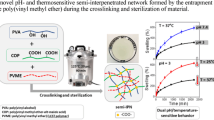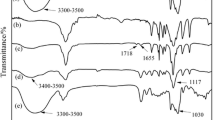Abstract
Polymeric hydrogels capable of reversible swelling with changes in environmental temperature and pH were synthesized and studied as matrix systems capable of controlled release of antithrombotic drugs to the site of a blood clot. Monomers N-isopropylacrylamide (NIPAAm) and methacrylic acid (MAA) were chosen for the temperature- and pHdependent swelling characteristics of their polymers, respectively. Equilibrium swelling studies were performed as functions of pH and of temperature, and kinetic swelling studies were performed on the thermally responsive gels as a function of time after the gel was subjected to a step-change in temperature. Experimental results indicate that P(NIPAAmco- MAA) hydrogels can be synthesized so that they are either pH- or temperaturesensitive, depending upon the composition of the network. The pure PNIPAAm gels showed a lower critical solubility temperature (LCST) of around 32°C, below which the gel was in its swollen state, and above which the gel collapsed. As the amount of methacrylic acid in the gels was increased, the degree of swelling in deionized water decreased and the temperature sensitivity was lost. The hydrogels containing MAA displayed a transition in swelling behavior between pH 4 and 6. The mesh sizes of the hydrogel networks were calculated from the results of the swelling studies by Flory-Rehner theory. A kinetic experiment on the temperature-sensitive pure PNIPAAm hydrogel showed that the polymer network collapsed rapidly upon temperature changes across the LCST.
Similar content being viewed by others
References
J. Garcia, M.P. Estrada, in Therapeutic Proteins: Pharmacokinetics and Pharmacodynamics, edited by A.H.C. Kung, R.A. Baughman and J.W. Larrick (W.H.Freeman and Company, New York, 1993) pp. 283–293.
M. Heskins, J.E. Guillet, J Macromol Sci - Chem, A 2, 1441 (1968).
A.S. Hoffman, in Polymers in Medicine III, edited by C. Migliaresi, (Elsevier Science Publishers, The Netherlands, 1988) p. 161.
A. Gutowska, Y.H. Bae, J. Feijen, S.W. Kim, J Controlled Release, 22, 95. (1992).
A.F.M. Barton. CRC Handbook of Polymer-Solvent Interaction Parameters, 1st ed. (CRC Press, Ann Arbor, 1990), pp. 566,578–579.
Y.H. Bae, T. Okano, S.W. Kim, J Polym Sci: Part B: Polym Physics, 28, 923 (1990).
Author information
Authors and Affiliations
Rights and permissions
About this article
Cite this article
Brazel, C.S., Peppas, N.A. Temperature- and pH- Sensitive Hydrogels for Controlled Release of Antithrombotic Agents. MRS Online Proceedings Library 331, 211–216 (1993). https://doi.org/10.1557/PROC-331-211
Published:
Issue Date:
DOI: https://doi.org/10.1557/PROC-331-211




